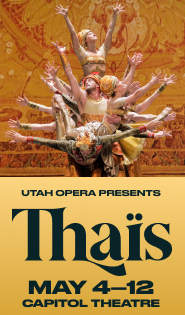Mozart and Respighi make a congenial pairing for Utah Symphony

In some interesting and rather unusual program choices, two quite different and distinctive halves make up the whole at this weekend’s Utah Symphony concert program in Abravanel Hall.
Opening the concert are two works by Mozart that are seldom performed here – the overture to his opera seria Idomeneo and the Sinfonia Concertante in E flat major, for violin and viola.
In Thierry Fischer’s hands, the overture at Friday’s performance received a dynamic, well-paced reading that underscored the stately character of the music. The playing by the rather oversized orchestra (by late 18th century standards) was crisp, decisive and rhythmically defined.
For the Sinfonia Concertante, German violinist Viviane Hagner was joined by the orchestra’s principal violist, Brant Bayless. The two played intuitively and sounded as if they had been collaborating for years rather than for a single weekend, their tones perfectly integrated to produce the musical partnership of equals that is at the core of this work. Fischer mirrored that balance in his carefully shaped and nuanced accompaniment.
The Sinfonia Concertante is neither flashy nor overly serious. Its considerable charm lies in its melodicism, which Hagner and Bayless captured in their finely expressed lyricism and well-crafted phrasings. The opening movement flowed smoothly, and the interplay between the violin and viola was nuanced and subtle.
The second movement Andante was given a delicately crafted reading by both the soloists and the orchestra that emphasized the expressive tenderness that Mozart created here. And the finale was played with a light, nimble touch and flair that projected the playful nature of the music.
The second half of the program featured Ottorino Respighi’s The Birds and The Pines of Rome, both from the 1920s. Neither has found a permanent place in the Utah Symphony’s repertoire, so it was a rare treat hearing them on Friday.
In The Birds, played first, Respighi bases each of the five movements on themes from early 18th century composers and cleverly updates them, much like Stravinsky did with Pergolesi’s music for his ballet Pulcinella. The tunes Respighi chose are well-suited for the birds that are depicted in the piece after the prelude — dove, hen, nightingale and cuckoo — and Fischer captured the distinctive characteristics of each with well-defined expressions and articulation.
The prelude was given a decisive reading that was bold but also bright and airy. Fischer’s well-chosen tempo for “The Dove” was spot on, capturing the soft lyricism of the music, and James Hall’s expressive oboe solos were fluid and wonderfully phrased.
“The Hen” is filled with humor and Fischer captured the pecking character of the music, with the orchestra playing crisply and precisely. Fischer underscored the reflective and impressionistic mood of the following “Nightingale” with billowy, sweeping lines. Nimble ensemble work carried along the burbling closer, “Cuckoo.”
Fischer then inserted another avian piece, the second movement (“The Orioles”) from Olivier Messiaen’s Des canyons aux étoiles. The interpretation was concise and succinct, with the symphony’s principal keyboardist, Jason Hardink, giving a stellar account at the piano.
Rounding out the evening was Respighi’s The Pines of Rome. Depicting specific locations around Rome, the work demands a cohesive reading to bring seamless flow between the four movements, and Fischer succeeded in creating a finely crafted whole.
In the opening movement, “The Pines of the Villa Borghese,” Fischer captured the pungent sounds and rhythmic vitality of the music with his brisk tempo. There was a restless energy that flowed through the orchestra and emphasized the sunny mood of the music.
The following “The Pines Near a Catacomb,” was distinguished by principal trumpet Travis Peterson’s wonderfully expressed offstage playing. And Fischer brought a quiet, almost otherworldly tone to his reading that was at times dark and ominous.
The third movement, “The Pines of the Janiculum,” with its impressionist harmonic language, had a shimmering quality in Fischer’s interpretation. Principal clarinetist Tad Calcara’s solo playing was dreamy and nuanced.
The closing “The Pines of the Appian Way” starts out rather menacingly, but quickly turns into one long crescendo. And with Fischer the crescendo was slow and deliberate, and built to a tremendous climax to end the piece.
The program will be repeated 5:30 p.m. Saturday in Abravanel Hall. www.utahsymphony.org; 801-355-2787.
